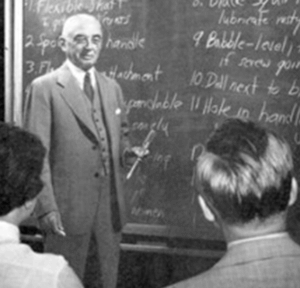10 Tactics to Generate BIG New Product Ideas

The sixth step of New Product Blueprinting is Brainstorming – when we are finally able to generate new product ideas. Some see brainstorming as highly important, something that a company should dedicate time, resources, facilitators, etc. On the other hand, some perceive brainstorming and ideation as overrated activities. Just excuses for employees to wear jeans offsite and play with Nerf toys.
We can be skeptical about methods for New Product Ideas
Do you remember the IBM commercial where an executive walked into a dark room, only to find his employees laying on the floor in the dark? He asked, “What are you guys doing?” And someone replied, “We’re ideating.” The executive rolled his eyes and says, “You’re idea-what?” As the commercial ends, the words, “STOP TALKING, START DOING” fill the screen.
So what is the truth? What should we think of brainstorming?
First, let’s recognize the obvious – that new ideas will fuel our innovation. Like all processes, brainstorming has best practices that can increase the quality of the output. However, unlike most business processes, the results are uncertain. There is no guarantee that a major game-changing new product idea will be created – nor even the guarantee of a minor product tweak. However, I submit that the real reason for pessimism regarding brainstorming that it’s often not done well – making counter-cultural techniques such as Nerf guns, etc. easy targets for frustration.
Tools can help for Voice of the Customer. Click here to learn more.
Five Basic Tactics for Bigger New Product Ideas
1. Begin with a problem to be solved
The input into a brainstorming process should always be a customer problem. This is the purpose of Discovery and Preference Research – to deliver problems to be solved. If a problem, task, job, desired outcome, etc. is important to a customer, and if they are unsatisfied with their ability to accomplish it today, then they will be receptive to a new product concept that addresses it. (Otherwise, you might solve some very interesting challenges that customers could care less about.)
When defining the problem, make sure and understand the contextual reasons behind it and the root causes. The good news is that if you have done Discovery Research, you will have this information within the “sticky notes” in your Blueprinter® software.

2. Embrace two distinct phases: divergence and convergence
When Alex Osbourne, an advertising man in the early 20th century, created the brainstorming process, he defined two phases – a divergence phase in which “all ideas are good.” During this phase, we reserve judgment. No negative comments are allowed. The goal during divergence is to generate a high quantity of new product ideas. Then afterwards, we apply judgment to determine the most feasible and impactful ones. Your Blueprinter software has separate tools for divergent and convergent phases.
3. Schedule adequate time
New product ideas requires thinking. And enough time for that thinking. Plan for a half-day at minimum for brainstorming. A full day is better. Participants should have been provided with a brief prior to the event – and the event itself should begin with a discussion of the problem.
4. Choose a diverse team
During divergence especially, include a mixture of backgrounds. Your team selection will begin with technical experts. Beyond that, include right-brain thinkers who are less restrained by the laws of physics, market experts who are intimately familiar with customer, and “wildcards” – those who have no knowledge or preconceptions about either.
5. Training
Conduct a brainstorming training session prior to the event. This can be as short as a one-hour web conference. It’s important that all participants understand the overall structure – and in particular – are aware that the team is to reserve judgment (and negative comments) during divergence which will suppress the flow of ideas.
Voice of Customer Tools can point to the best ideas! Click here to learn more.
Five Advanced Tactics for Bigger New Product Ideas
1. Capture new product ideas throughout Blueprinting interviews
During Blueprinting interviews, your team members will think of ideas to solve the problems that customers present. Capture these along the way, and add them into the divergent brainstorming session.
2. Change the location
Get offsite. Change the environment. Nontraditional sites like museums often will lease a meeting room or space for low cost during the week. It can be hard to create new product ideas in the same conference room where just yesterday, we endured a lecture from IT on cyber security.

3. Hire a facilitator
It’s hard to participate when you’re also the person executing the session. Plus, a professional facilitator will have a tool set to help guide the process. With the right trigger methods, a trained facilitator can uncover up to 30% more ideas. For all the expense and time that it takes to execute Blueprinting projects, it should be easy to justify a professional facilitator to improve the likelihood of a breakthrough new product.
4. Include an industrial designer or sketch artist
An industrial designer or sketch artist will make the concepts visual – and will help participants to build upon their initial thoughts. Additionally, with a designer or artist, you will have concept drawings for upper management when they want to see the results of a session. It’s not enough to only generate new product ideas, but we must communicate the idea internally.
5. Use both asynchronous and synchronous divergence
“Synchronous” just means that we all generate ideas together at the same time – usually in the same place. “Asynchronous” means that we capture ideas at different times. Going “asynchronous” doesn’t have to be high tech. You could provide participants a diary in which they can capture their ideas over 1-2 weeks or so…and then they can bring those to the actual session.
Big New Product Ideas are worth the effort
Brainstorming, otherwise known as idea generation or ideation, is where the magic happens. It is the payoff after the hard work of Discovery and Preference research. Embrace all of the five basic tactics – and consider adding some of the advanced tactics. While there’s no guarantee, you can certainly improve your odds of success.
Comments